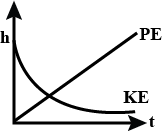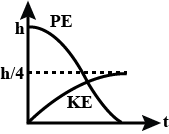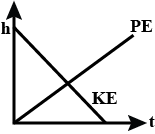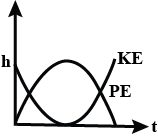
A raindrop falling from a height $h$ above the ground, attains a near terminal velocity when it has fallen through a height $\dfrac{3}{4}h$. Which of the diagrams shown in the figure correctly shows the change in kinetic and potential energy of the drop during its fall up to the ground?
A.

B.

C.

D.





Answer
569.4k+ views
Hint: When a body falls freely under the influence of the gravitational force, its potential and kinetic energy changes during its motion but the sum of the potential energy and kinetic energy at every point remains constant.
Complete step by step answer:When a raindrop falls freely, then at a height $h$ above the ground its potential energy is maximum and kinetic energy is zero. During the fall, the potential energy of the raindrop keeps decreasing and kinetic energy goes on increasing up to a height $\dfrac{h}{4}$ above the ground. At this stage, rain drop has acquired terminal velocity. Thereafter its velocity remains constant. Therefore, at this stage, kinetic energy becomes constant. Potential energy becomes zero when a raindrop falls to the ground.
Hence, option (B) is correct.
Note:When a body falls freely through the atmosphere, two external forces will act on it. One of them is the gravitational force, expressed as the weight of the object. The other force is the air resistance, or drag of the object. An object dropped from rest such as a raindrop will increase its speed until it reaches terminal velocity. When terminal velocity of the object is achieved, then the speed of a moving object is no longer increased or decreased, that is the object’s acceleration becomes zero. At terminal velocity the air resistance equals in magnitude to the weight of the falling object. As the two forces are oppositely directed, the total force on the object is zero and the speed of the object becomes constant.
Complete step by step answer:When a raindrop falls freely, then at a height $h$ above the ground its potential energy is maximum and kinetic energy is zero. During the fall, the potential energy of the raindrop keeps decreasing and kinetic energy goes on increasing up to a height $\dfrac{h}{4}$ above the ground. At this stage, rain drop has acquired terminal velocity. Thereafter its velocity remains constant. Therefore, at this stage, kinetic energy becomes constant. Potential energy becomes zero when a raindrop falls to the ground.
Hence, option (B) is correct.
Note:When a body falls freely through the atmosphere, two external forces will act on it. One of them is the gravitational force, expressed as the weight of the object. The other force is the air resistance, or drag of the object. An object dropped from rest such as a raindrop will increase its speed until it reaches terminal velocity. When terminal velocity of the object is achieved, then the speed of a moving object is no longer increased or decreased, that is the object’s acceleration becomes zero. At terminal velocity the air resistance equals in magnitude to the weight of the falling object. As the two forces are oppositely directed, the total force on the object is zero and the speed of the object becomes constant.
Recently Updated Pages
Why are manures considered better than fertilizers class 11 biology CBSE

Find the coordinates of the midpoint of the line segment class 11 maths CBSE

Distinguish between static friction limiting friction class 11 physics CBSE

The Chairman of the constituent Assembly was A Jawaharlal class 11 social science CBSE

The first National Commission on Labour NCL submitted class 11 social science CBSE

Number of all subshell of n + l 7 is A 4 B 5 C 6 D class 11 chemistry CBSE

Trending doubts
What is meant by exothermic and endothermic reactions class 11 chemistry CBSE

1 Quintal is equal to a 110 kg b 10 kg c 100kg d 1000 class 11 physics CBSE

Difference Between Prokaryotic Cells and Eukaryotic Cells

What are Quantum numbers Explain the quantum number class 11 chemistry CBSE

What is periodicity class 11 chemistry CBSE

Explain zero factorial class 11 maths CBSE




